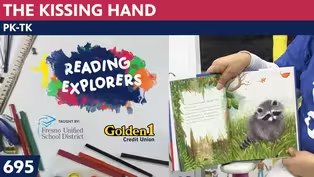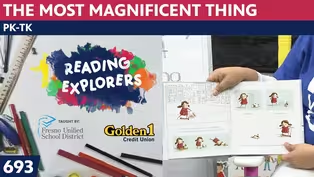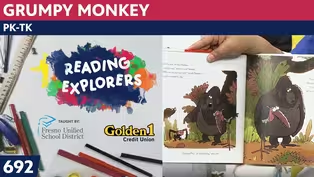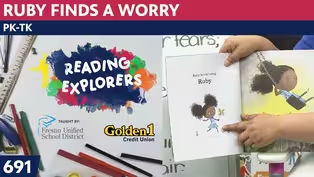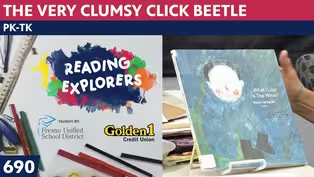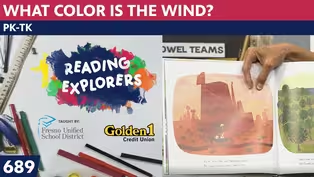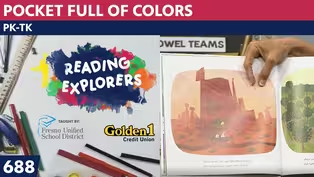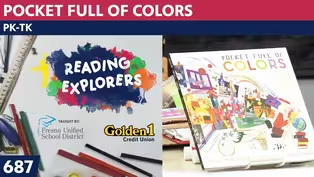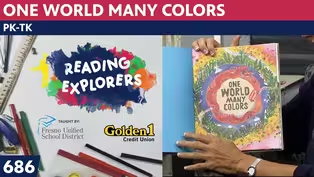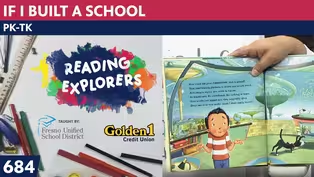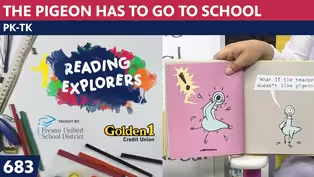
TK-371: Marc Chagall - I and the Village
Season 3 Episode 397 | 14m 8sVideo has Closed Captions
Join me today as we begin a study of one of my favorite artists, Marc Chagall.
Join me today as we begin a study of one of my favorite artists, Marc Chagall.. Each day we will enjoy a Chagall masterpiece that shows his dreamlike art. Today's art is "I and the Village". We will learn to create Chagall-like art using the Elements of Art. (line, color, shapes in many sizes, objects and people right side up...and some upside down.)
Problems playing video? | Closed Captioning Feedback
Problems playing video? | Closed Captioning Feedback
Reading Explorers is a local public television program presented by Valley PBS

TK-371: Marc Chagall - I and the Village
Season 3 Episode 397 | 14m 8sVideo has Closed Captions
Join me today as we begin a study of one of my favorite artists, Marc Chagall.. Each day we will enjoy a Chagall masterpiece that shows his dreamlike art. Today's art is "I and the Village". We will learn to create Chagall-like art using the Elements of Art. (line, color, shapes in many sizes, objects and people right side up...and some upside down.)
Problems playing video? | Closed Captioning Feedback
How to Watch Reading Explorers
Reading Explorers is available to stream on pbs.org and the free PBS App, available on iPhone, Apple TV, Android TV, Android smartphones, Amazon Fire TV, Amazon Fire Tablet, Roku, Samsung Smart TV, and Vizio.
Providing Support for PBS.org
Learn Moreabout PBS online sponsorshipMore from This Collection
Valley PBS and Fresno Unified School District have partnered with Golden 1 Credit Union to create Reading Explorers Lessons for grades Pre-Kindergarten through Third grade. The daily lessons will be taught by Fresno Unified School District teachers and are created to help students practice their reading skills and reinforce lessons during distance learning.
Video has Closed Captions
Valley PBS presents Reading Explorers Lessons for Pre-Kindergarten and TK. (26m 27s)
PK-TK-693-The Most Magnificent Thing
Video has Closed Captions
Valley PBS presents Reading Explorers Lessons for Pre-Kindergarten and TK. (26m 26s)
Video has Closed Captions
Valley PBS presents Reading Explorers Lessons for Pre-Kindergarten and TK. (26m 28s)
Video has Closed Captions
Valley PBS presents Reading Explorers Lessons for Pre-Kindergarten and TK. (26m 28s)
PK-TK-690: The Very Clumsy Click Beetle
Video has Closed Captions
Valley PBS presents Reading Explorers Lessons for Pre-Kindergarten and TK. (26m 22s)
PK-TK-689: What Color is the Wind?
Video has Closed Captions
Valley PBS presents Reading Explorers Lessons for Pre-Kindergarten and TK. (26m 21s)
PK-TK-688: Pocket Full of Colors
Video has Closed Captions
Valley PBS presents Reading Explorers Lessons for Pre-Kindergarten and TK. (25m 58s)
PK-TK-687: Dancing Through Fields of Colors
Video has Closed Captions
Valley PBS presents Reading Explorers Lessons for Pre-Kindergarten and TK. (26m 20s)
PK-TK-686: One World Many Colors
Video has Closed Captions
Valley PBS presents Reading Explorers Lessons for Pre-Kindergarten and TK. (27m 13s)
PK-TK-685: School is Wherever I am
Video has Closed Captions
Valley PBS presents Reading Explorers Lessons for Pre-Kindergarten and TK. (26m 32s)
PK-TK-684: If I Built a School
Video has Closed Captions
Valley PBS presents Reading Explorers Lessons for Pre-Kindergarten and TK. (26m 21s)
PK-TK-683: The Pigeon Has to Go to School
Video has Closed Captions
Valley PBS presents Reading Explorers Lessons for Pre-Kindergarten and TK. (26m 22s)
Providing Support for PBS.org
Learn Moreabout PBS online sponsorship♪ Good morning to a brand new day ♪ ♪ Time to learn and the games to play ♪ ♪ Learning things is so much fun ♪ ♪ Learning is good for everyone ♪ (lively music) - Hello, early learners.
And welcome back to the art room.
Let's start our day with our hello song.
♪ Hello, nice to see you, everyone ♪ ♪ Hello, nice to see you, everyone ♪ ♪ Hello to you, hello to you ♪ ♪ Hello to you, hello to me ♪ ♪ Hello, nice to see you, everyone ♪ Boys and girls, in Fresno Unified, the TK classes are starting a lesson about Marc Chagall.
Now, Mark Chagall is my favorite artist.
I used to think it was Van Gogh but then Marc Chagall does a lot of things with animals and villages.
And I think that I made him my favorite after reading this book called "Journey on a Cloud" that I'm going to show you on Thursday.
But today is mystery Monday.
So let's take a look and see what's inside the suitcase.
And they all have to do with Marc Chagall.
I'll get out a bunch of things first and show you these things.
Whoa, they tried to fall.
Come here, you.
In a lot of Marc Chagall's work, you will see chickens or roosters.
Now, chickens and roosters are in his pictures for reasons because he lived in a small village and chickens and roosters were all over the village.
He also adds sheep or lambs to his pictures, cows and goats.
So he doesn't always put them right side up or in a place that you would look at and think, oh, well that chicken belongs there.
Oftentimes, they're floating in the sky.
So here's the first things I brought out of the suitcase and I'm gonna move them over so that I can bring out the next thing.
So some of the art that we do this week will have farm animals in it.
Other things, you will see people playing violins.
I brought my tiny pin violin.
I was going to wear it, but the clasp broke.
And then, you know what this is.
It's a house with two chimneys and they might be found in a village lined up, lots of small houses.
Let me move this aside.
So we have farm animals, village houses, violins.
And my final thing is the church.
Churches and temples are in his art.
And this one doesn't have a cross on it.
But when we look at the picture today, I'm going to ask you to look and see if you can find a place where you see a church or a temple because we'll be adding that to our picture too.
So let's set this aside and move this.
I also wanted to show you, soon I'm going to be holding a family art night, and I wanted to show you how I'm going to carry my art supplies.
I just put a little box and put art box on it so that I can carry maybe my brand new set of paints.
But if you have a little box and you want to keep your art supplies in it, I think it will keep them safe.
I always tell you to put your things away but if you don't have a little box or a shoe box to keep it in, where do you keep it?
All right, I'm going to set this down and get my pointer stick to show you "I and the Village."
"I and the Village."
Let's look at the chart and see what our artist looks like.
Here he is, Marc Chagall.
He was born in 1887.
He lived 98 years.
He lived 98 years and most of them, he continued to do his art.
And this is the picture we're talking about today.
Now, let's look at some of the things I told you will be in the artwork.
People disagree on this.
Some people think it's a goat, some think it's a cow.
You can decide what you think it looks like.
Here, a goat is being milked.
He does upside down people, upside down houses, right side up people, and right side up houses.
He often will put a green man playing a violin.
In this picture though, the woman is playing the violin.
He also shows the tree of life.
And here the person is holding it and they're wearing a ring.
And we ask, how can you find rings in the picture?
So there's this ring.
The goat has the ring in its nose.
There's also a cross here around this person's neck and a cross at the top of the church or temple.
And he is wearing a hat.
They say that this was a self portrait of Marc Chagall.
And he made himself green for a reason only he knows but he always includes a village in his pictures in some way.
So we're going to be doing lots of village things this week but today we're going to be doing "I and the Village" by drawing on a piece of paper.
So I have put this on an easel because I thought it would be easier for you to see.
So keep looking at it.
And I'm going to move my suitcase out of the way, which you won't see because I'm doing it while you look at the picture.
Let me move the table over and let's take a look what we have.
So I'm going to start with the goat's eye.
and I'm using a black permanent marker.
You can use a black crayon or you can use a black pastel, but let's take a look.
This paper is very long and I may not use the whole thing but about in the middle, a little this side of the middle, I'm starting his eye, and it is a curved line.
And you can do that.
Underneath is another curved line.
Now, when we make an eyeball, you don't want to make the circle right in the middle.
Part of it is up into the eyelids.
So you just make a curved line here and a curved line here.
Then the pupil is put in the middle of that.
Over here is another kind of curved line to show you the black area around the eye.
And I think I will color that in.
I don't usually do this with my permanent pen but I want to remember that that needs to be there 'cause this part is the white of the eyes.
So from the eye, I'm going to go up because that's where his ear is going to go.
So I'm going to do somewhat of a triangle, a triangle ear there.
Over here is going to be another triangle.
I'm going to go down his back to the edge of the paper.
I'll wait a second if you need to catch up.
From the corner of his eye, we're going to take that to the edge of the paper.
So I've just done this part.
And now I'm going to do the front of his face.
I'm going down at an angle.
I go to the end, go in for his mouth, over a tiny bit and make his lower jaw.
Once I get there, I will make his jaw curve up to that line.
He has that ring in his nose.
And do you know why people put rings in their farm animals' noses?
Because they dig, dig, dig with their nose.
And if they have a ring in there, it doesn't feel comfortable to them and they won't continue digging.
Now, on this part, I'm going to go down and begin to put his necklace on and it's a string of circles.
So they look kind of like a pearl.
You see how I'm going up and I'm going to meet where his neck reached the paper.
Now, I'm going to draw the green man.
And his nose is really a triangle.
There are lots of triangles in here and pie shapes that we're going to replicate or make ourselves.
So let me do this here.
I'm going to go across from the goat's forehead and make that big triangle nose.
When it reaches that part, I'm going to do the little curve part just like on our nose on that side.
He needs that nostril that goes up, and I colored it black.
On his upper lip, we'll go down.
Now, there is a little heart shaped lips.
So I put the lips in like that.
Now, I'm going to do his chin down and curve in.
He'll need a neck too, because he has a necklace too.
And on his, if you want to, you can put the cross hanging from it.
It has like a little chain and then the cross.
Let's put it his eye.
And that also is a triangle with the eyeball right there.
He's wearing a hat on his head.
It goes up.
So the curved line goes up and in.
And then the top part is there's like a little ribbon here and the top of this hat.
Now, we have the green man.
Here, when you smile, there's a little circle like that will come when you smile.
And you can just pretend it's going through his face and it makes a circle.
It goes where the goat is.
We're going across, under the goat's face.
So I pretend I'm coming through and I go around and make it come down to about here because that's where the tree of life is going to be.
So I'm making the tree of life.
It's just a skinny one with some branches and branches.
I'm doing a couple more branches up here.
And all in the picture are round circles that look like leaves or fruit.
So I'm going to put lots of circles to make the leaves or fruit.
Now, boys and girls, I put on the website "I and the Village" a picture for the Fresno Unified teachers.
But if you look it up, you can bring it up on your computer.
And if you want to add more things to your picture, I'm going to either use my pastels or I'm going to use some water colors.
You decide how you want to color this.
I also wanted to show you, it's kind of sketched on the face of a goat being milked.
So I'm going to put, I like to start with the ears and it's just going to be a sketch.
I go to his face, kind of like we did this face, the legs, and it's being milked.
So I can't go all the way across its body.
Here's the milkers head.
Their arms are kind of curved down, ready to milk the goat.
And here's the waist.
And it looks like they're sitting on a little stool.
So that's my good start to it.
And if you would like to see when I color it in, we'll be able to see this next week.
I'll color it in and show you how I made the circle and how it came around.
And the rest of the circle came around to meet it here.
And there's another circle here.
And we'll talk about this and work on this over the weekend and bring it back.
Now, tomorrow, we're going to look at another village picture and it is going to be sun on the village.
So I need you to bring white paper, a black permanent pen, coloring tools.
And if you want to use your watercolors, you'll need to bring a brush and some water.
So boys and girls, we did "I and the Village," tomorrow, sun on the village and you can begin painting and making it colorful.
I'll sing goodbye to you right now and start a little bit of my painting by bringing my paintbrush up here.
♪ Goodbye, see you next time, everyone ♪ ♪ Goodbye, see you next time, everyone ♪ ♪ Goodbye to you, goodbye to you ♪ ♪ Goodbye to you, goodbye to me ♪ ♪ Goodbye, see you next time, everyone ♪ I'm gonna paint some of this background like this.
Boys and girls, do you see?
Just putting paint here.
I might use my pastels too.
See you next time, boys and girls.
Bye, bye.
(guitar music) ♪ Good morning to a brand new day ♪ ♪ Time to learn and games to play ♪ ♪ Learning things is so much fun ♪ ♪ Learning is good for everyone ♪ (guitar music)
Support for PBS provided by:
Reading Explorers is a local public television program presented by Valley PBS
